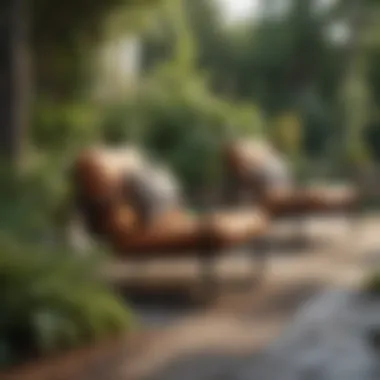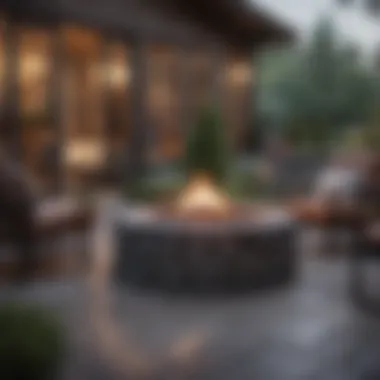Exploring Outdoor Furniture Options for Your Space


Intro
In contemporary living, outdoor spaces have transitioned from mere extensions of indoor areas to vital components of homemaking and lifestyle. Selecting appropriate outdoor furniture can significantly enhance the aesthetic and functional appeal of these spaces. The process involves establishing a balance between design, durability, and comfort tailored to the specific environment of your home. This guide is aimed at assisting homeowners, renters, and design enthusiasts in navigating the complex world of outdoor furniture options, ensuring thoughtful choices that elevate their outdoor experiences.
Design Inspiration
Creating a harmonious outdoor environment begins with understanding design inspiration. The outdoor area can reflect personal style, much like interior spaces. By incorporating current trends in outdoor furniture design, one can curate an inviting space suitable for relaxation or entertaining guests.
Current Trends in Outdoor Furniture
The trend towards sustainable materials is gaining traction. Many consumers now opt for furniture made from recycled materials or sustainably harvested woods. Additionally, modular furniture systems that adapt adapt to various spaces are also popular. This flexibility allows homeowners to reconfigure their settings for different occasions.
Another emerging trend is the blend of indoor and outdoor aesthetics. Many furniture pieces now feature plush fabrics, intricate designs, and color schemes typically seen indoors. This trend provides an opportunity to create cohesive aesthetics throughout the home.
Color Schemes and Palette Ideas
Choosing the right color palette is crucial for establishing mood and ambiance. Muted tones like beige, soft greens, and grays evoke a serene environment, while vibrant colors such as turquoise and coral can create a lively atmosphere. Consider the natural elements surrounding your space when selecting colors.
Key color combinations include:
- Earthy tones paired with rich greens for a natural look.
- Monochromatic palettes featuring different shades of a single color.
- Bright accents against neutral bases to add visual interest.
"Color can greatly impact the feeling of a space; proper selection evokes the desired atmosphere and enhances overall enjoyment."
The Purchasing Journey
When considering outdoor furniture, several factors require attention to make sound purchasing decisions. Quality and durability are paramount, given exposure to various weather conditions. Opt for materials like aluminum, teak, or synthetic rattan that can withstand moisture and UV rays.
Local Options for Outdoor Furniture
To find quality outdoor furniture near you, explore local retailers or check websites. Stores like Home Depot and Lowe's often carry a range of affordable options. Additionally, support local craftspeople in your community who create unique, bespoke pieces.
Utilizing platforms like Facebook Marketplace and Reddit can also provide leads on great deals or second-hand finds. Many towns and cities host outdoor furniture shows where local artisans showcase their work, offering a chance to see products firsthand.
Maintenance Considerations
Maintenance is essential in prolonging the life of outdoor furniture. Regular cleaning, protective treatments, and storage techniques can prevent wear and tear. Seasonal changes might necessitate storing certain items indoors to avoid damage.
Tips for Maintaining Outdoor Furniture
- Cleaning: Use mild soap and warm water; avoid harsh chemicals.
- Protective Treatments: Apply water repellent and UV-blocking sprays.
- Storage: Invest in protective covers for inclement weather.
Understanding Outdoor Furniture
The realm of outdoor furniture encompasses various elements that play an essential role in how we experience our outdoor spaces. Understanding outdoor furniture is crucial because it influences not just style but also functionality and comfort in your garden, patio, or balcony. This knowledge helps in making informed decisions that align with your lifestyle and aesthetic preferences.
When considering outdoor furniture, one must reflect on its intended purpose—whether it be for relaxation, dining, or entertaining guests. Each choice comes with its own set of benefits and considerations that warrant careful evaluation. Proper understanding can aid you in selecting pieces that endure the elements, enhance the beauty of your landscape, and facilitate enjoyable outdoor activities.
Definition and Purpose
Outdoor furniture refers to furniture specifically designed for outdoor use. Unlike indoor varieties, these pieces are constructed to withstand various weather conditions, including rain, sun, and wind. The primary purpose of outdoor furniture is to create inviting spaces where individuals can gather, relax, and enjoy nature.
The definition extends beyond just traditional settings like patios and decks. Outdoor furniture can also transform gardens, pool areas, and balconies into functional areas for leisure. Its purpose is to enhance outdoor living, making it an essential aspect of property design for many homeowners.
Key Categories of Outdoor Furniture
The landscape of outdoor furniture is diverse. Key categories include seating options, tables, and accessories, each contributing to the overall functionality and aesthetic appeal of outdoor settings.
Seating Options
Seating options are perhaps the most critical aspect when planning outdoor spaces. They allow for comfort during gatherings and individual moments of peace. Popular choices include lounge chairs, benches, and dining sets. The versatility of seating caters to various needs, whether for lounging or dining.
A defining characteristic of seating options is their adaptability. Many contemporary styles offer a fusion of aesthetics and comfort, making them suitable for both casual and formal settings.
Advantages of good seating choices include durability and prolonged comfort. However, they often require occasional maintenance, especially in harsh weather conditions.
Tables
Tables serve as vital components for any outdoor setting. They provide surfaces for dining, playing games, or displaying decoration. Different styles like coffee tables or dining tables enhance the interaction among guests.
One notable aspect of outdoor tables is their stability. High quality tables usually come with weight and heft that withstand wind and storms. They're designed for usage, ensuring they can handle meals, drinks, or activities.
Unique features may include extendable tops or weather-resistant finishes, though these can come with varying price points needing careful budget considerations.
Accessories
Accessories enrich outdoor living by adding character and functionality. This category includes items like cushions, umbrellas, and fire pits, which help create a cohesive look while enhancing usability.


A key characteristic of accessories is their ability to transform a space easily. They are often relatively affordable and can be replaced or updated with seasons or trends.
However, relying heavily on accessories without solid foundational furniture can lead to clutter. Therefore, it's crucial to balance essential and decorative elements for optimal outdoor aesthetics.
It is important to see outdoor furniture not just as items, but as integral parts of your outdoor experience.
Materials Used in Outdoor Furniture
The selection of materials in outdoor furniture is crucial. Each material lends itself to specific styles, durability, and maintenance needs. Understanding the various options not only aids in making an informed choice but also enhances the sustainability and aesthetics of your outdoor space. Factors like local climate, desired longevity, maintenance preferences, and overall design theme are important to consider. In this section, we will explore the common materials used for outdoor furniture, their benefits, and specific characteristics.
Wood Options
Teak
Teak wood is highly regarded for outdoor furniture due to its strong, durable nature. Its high oil content provides natural resistance to water and pests. This characteristic makes teak a popular choice for various weather conditions. Additionally, its visual appeal remains intact over time, requiring minimal maintenance. A unique feature of teak is its ability to develop a beautiful silvery patina if left untreated. This can enhance the aesthetic of outdoor spaces. However, its cost can be a limitation for some buyers.
Acacia
Acacia wood offers a balance between affordability and quality. It is dense, durable, and can withstand outdoor elements. Acacia's natural grain patterns amplify its charm, making it visually appealing. This material is often used in seeking elegant but cost-effective outdoor furniture solutions. While it requires regular oiling to maintain its luster, the effort is worthwhile. However, exposure to harsh weather conditions can lead to fading over time, which some might find undesirable.
Recycled Wood
Recycled wood presents an eco-friendly option for outdoor furniture. This material enables sustainable living by repurposing old wood into new furniture designs. Its charm comes from its varied textures and hues, providing a unique aesthetic unlike uniform alternatives. One significant advantage of recycled wood is its lower environmental impact. Nevertheless, buyers must understand that the quality can vary based on the source of the recycled material, which may affect durability.
Metal Choices
Aluminum
Aluminum is favored for outdoor furniture as it is lightweight yet robust. This material resists rust, making it an prime choice for areas with high humidity or coastal climates. The ease of maintenance and variety of finishes available enhances its appeal. Aluminum furniture can be moved easily for rearrangements without much effort. On the downside, if not treated properly, it can get warm in direct sunlight, making it less comfy to sit on during hot days.
Iron
Iron is known for its strength and sturdiness. It is often used in classic designs and heavier furniture pieces. The unique heritage vibe of wrought iron furniture can bring an elegant touch to outdoor settings. Though it offers durability, it requires regular maintenance to prevent rusting, especially in wet climates. The weight of iron can be a double-edged sword; stability can be a benefit against winds, but moving it can prove difficult.
Stainless Steel
Stainless steel is frequently selected for its modern appearance and resistance to corrosion. This material withstands harsh weather conditions wonderfully and requires minimal upkeep, making it a practical choice. A key characteristic is its sleek look, which complements contemporary outdoor aesthetics. However, it can become very hot when exposed to sunlight, making it uncomfortable without cushions.
Plastic and Synthetic Materials
Polyethylene
Polyethylene is a durable synthetic option often used in outdoor furniture. It resists fading, cracking, and peeling, making it ideal for long-term use in varying weather conditions. This material also requires very little maintenance, appealing to busy owners. Its lightweight nature adds to its convenience, enabling easy rearrangements. One downside is that it might not match the aesthetic of more traditional materials for those seeking a classic design.
Resin
Resin furniture is made from molded synthetic materials that can replicate the look of natural materials like wicker. This outdoor furniture is resistant to various elements, including moisture and UV rays. Also, it’s lightweight and easy to clean, catering to a modern lifestyle. However, the manufacturing process can involve chemicals, raising concerns for environmentally conscious buyers.
Recycled Materials
Recycled materials have gained popularity for outdoor furniture due to growing environmental awareness. They can include plastics and composites made from recovered materials. These options help reduce landfill waste while providing unique textures and colors. They are often designed to endure different weather conditions. However, the quality and durability can vary widely among products, so careful selection is necessary.
Choosing the right material for your outdoor furniture is essential as it directly impacts durability, maintenance, and overall appearance.
Choosing the Right Outdoor Furniture
Choosing the right outdoor furniture is a critical task that requires thoughtful consideration of various factors. The outdoor area serves as an extension of your home and choosing quality, suitable furniture can enhance its functionality and aesthetics. Proper selection can transform a simple patio or garden into a welcoming retreat for family and friends. This process is not merely about aesthetics but also involves practical aspects such as durability, comfort, and maintenance.
One key element to consider is how you plan to use your outdoor space. Will it be a casual lounge area for relaxation or a space for hosting gatherings? Understanding the purpose your outdoor area serves can significantly influence your furniture choices.
Additionally, properly chosen outdoor furniture will complement your outdoor environment. It needs to harmonize with your landscaping, architecture, and other decor elements. Neglecting to think about these important aspects can lead to a mismatched look that detracts from the overall aesthetic.
Estimating Space and Layout
Estimating space and layout is fundamental in the process of selecting outdoor furniture. Before making any purchases, measure the area available for your furniture. This ensures that the selected pieces will fit comfortably without overwhelming the space. An overcrowded outdoor area can feel cramped and uninviting.
Creating a simple layout plan can provide clarity. Consider where you want to place seating, tables, and other accessories. Some key considerations include:
- Traffic flow: Ensure pathways between furnishings are clear and allow for easy movement.
- Seating arrangements: Think about how many people you want to accommodate. This affects how much seating you need.
- Zoning: If your outdoor area is large, dividing it into zones can create distinct spaces for different activities, such as dining and lounging.
Matching Style and Aesthetics
Matching style and aesthetics is vital in creating a cohesive look for your outdoor area. Furniture should reflect your personal style and harmonize with the surrounding environment. When selecting pieces, consider the architectural style of your home, as well as the landscape.
You might opt for a sleek modern design with clean lines for a contemporary home, or perhaps a classic wicker style for a more traditional setting. Ultimately, the goal is to create visual flow between your home and outdoor space.
- Color Schemes: Select colors that complement your existing decor.
- Textures: Mixing materials thoughtfully can add depth. Consider combining wooden furniture with metal accents.
- Theme: Establishing a clear theme can help in making consistent choices regarding style and design.
Assessing Durability and Maintenance


Understanding durability and maintenance requirements is crucial for outdoor furniture selection. Outdoor furniture is exposed to the elements and thus needs to withstand weather conditions such as rain, sun, and wind. Consequently, materials should not only be aesthetically pleasing but also robust and weather-resistant.
Some points to take into account:
- Material Quality: High-quality materials like teak or aluminum offer better durability compared to cheaper alternatives.
- Maintenance Needs: Some pieces require more care than others. For instance, wood furniture might need regular treatments, whereas metal can often be wiped clean easily.
- Longevity: Investing in durable options may be more cost-effective in the long run, reducing the need for frequent replacements.
Choosing the right outdoor furniture involves a balance of practicality and style. Making informed decisions based on usage, space, design preferences, and maintenance can help create an inviting outdoor living space.
Finding Outdoor Furniture Near You
Finding suitable outdoor furniture is a crucial endeavor for anyone looking to enhance their outdoor spaces. This section dives into the various avenues available for locating and selecting outdoor furniture in your vicinity. The right outdoor furniture not only elevates the aesthetic appeal of your backyard or patio but also adds functionality and comfort to these areas, making them more enjoyable for gatherings or quiet nights under the stars. Understanding where to shop is essential as it allows you to explore different styles, materials, and price points.
Local Retailers and Showrooms
Visiting local retailers and showrooms offers an invaluable opportunity to physically experience outdoor furniture before making a purchase. The tactile aspect is significant; sitting down on a chair or testing the sturdiness of a table can help one gauge comfort and quality. Moreover, local establishments often showcase a variety of pieces that might not be available online, thus catering to specific design sensibilities or regional styles. When visiting, engage with the staff, as they can provide insights about product origins, maintenance tips, and warranty details.
Benefits of Shopping Locally:
- Immediate possession of the items
- Potential discounts during sales
- Supporting local businesses, which boosts the local economy
- Personalized customer service and expert guidance
Online Platforms and Marketplaces
E-commerce has revolutionized how we shop for outdoor furniture. Sites like Wayfair, Amazon, and Etsy offer extensive selections that allow for easy comparison shopping. The virtual setting presents an opportunity to filter products based on your budget, preferred materials, or design themes. However, online shopping comes with its own challenges. Notably, the inability to inspect the furniture firsthand may lead to mismatches in expectations.
To mitigate risks, always check product reviews and ratings, paying particular attention to comments about durability and customer service. Gather product dimensions and visualize how the items will fit in your designated space before the purchase. Many online retailers also offer return policies, which can further ease concerns for hesitant buyers.
Craft Fairs and Local Artisans
Craft fairs and local artisans represent a unique and personalized way to find outdoor furniture. This path not only supports creativity but also promotes sustainability, as many of these craftspeople use reclaimed or eco-friendly materials. At a craft fair, you can view one-of-a-kind pieces that tell a story, offering a distinct charm that mass-produced furniture lacks.
Engaging with artisans allows consumers to gain insight into the craftsmanship behind each item. You might even have the chance to commission custom work tailored to your specific preferences.
When exploring local fairs, be prepared to ask questions about the materials used, the inspirations behind the designs, and any available maintenance advice:
- What finishes are used?
- Is there a warranty?
- How should I clean it?
Supporting local artisans not only enhances your outdoor space but also fosters community and sustainability.
In sum, whether through local retailers, online platforms, or craft fairs, the journey to finding outdoor furniture can be rewarding and enriching. Engaging with different sources opens up possibilities that cater to unique tastes and preferences. This enables one to create an outdoor environment that truly reflects their style.
Sustainable Outdoor Furniture Options
Sustainable outdoor furniture is becoming increasingly relevant as people recognize the environmental impact of their choices. As we enhance our outdoor spaces, it is crucial to consider sustainability and how it shapes not only aesthetics but also ecological footprints. Choosing sustainable materials can lead to long-term savings, reduced waste, and a healthier planet. This section will explore the importance of sustainability in outdoor furniture, along with eco-friendly materials that align with these principles.
The Importance of Sustainability
Sustainability in outdoor furniture means selecting products that minimize environmental harm. This involves not just the materials used but also the processes in creating these items. By making informed choices, consumers help reduce deforestation, pollution, and waste. A sustainable approach often results in durable products, which means fewer replacements are necessary over time.
Moreover, sustainable outdoor furniture reflects a growing trend among consumers who are increasingly aware of their choices. Many designers and manufacturers now prioritize eco-conscious practices. These actions align with a broader commitment to sustainability in lifestyle and design. Investing in sustainable options can contribute to a sense of responsibility and purpose.
Eco-Friendly Materials
Reclaimed Wood
Reclaimed wood is often highlighted for its sustainability. It comes from old buildings, furniture, or even shipping pallets, thus preventing waste. The key characteristic of reclaimed wood is its uniqueness; each piece carries its own stories, textures, and imperfections. This fact can make reclaimed wood furniture a popular choice for many who want a one-of-a-kind piece in their yard.
However, sourcing is vital. Proper restoration ensures that reclaimed wood is safe and durable. Furthermore, using reclaimed wood can be more costly, but its long-term benefits often outweigh the upfront price.
Bamboo
Bamboo is another strong contender in the sustainable materials category. This grass type grows quickly and can be harvested without killing the plant. Its key characteristic is its strength combined with lightweight properties, making it suitable for various outdoor furniture styles. For those looking to balance aesthetics with sustainability, bamboo is a beneficial choice.
In addition to its positive environmental impact, bamboo furniture has a natural appeal. However, bamboo can require more maintenance than other materials. Exposure to extreme weather can make it susceptible to warping or cracking without proper care.
Recycled Plastics
Recycled plastics have gained traction as a practical and sustainable material for outdoor furniture. These plastics are made from post-consumer waste, which helps reduce landfill contributions. The key characteristic of recycled plastics is their durability; they resist weather elements much better than traditional materials. Thus, they require less maintenance over time, making them a cost-effective option in the long run.
Despite these advantages, some consumers may be concerned about the aesthetic qualities of recycled plastics. However, many manufacturers have made excellent strides in creating products that are appealing and functional.
"Sustainable choices in outdoor furniture can significantly reduce your environmental impact while enhancing your outdoor space."
By exploring these eco-friendly materials, consumers can discover how their furniture choices can contribute to a sustainable future.
Maintaining Outdoor Furniture
Maintaining outdoor furniture is essential for several reasons. First, it extends the life of your investment. Outdoor environments can be harsh due to weather, sunlight, and general wear. Proper care ensures that your furniture remains functional and aesthetically pleasing over time. Additionally, regular maintenance can enhance safety; worn or damaged furniture can pose risks during use. Finally, a well-maintained outdoor space creates an inviting atmosphere for gatherings.


Cleaning Techniques
Cleaning your outdoor furniture regularly is a fundamental part of maintenance. Depending on the material, different cleaning techniques may be more effective. For instance, wood furniture often benefits from a mixture of mild soap and water. This should be applied with a soft cloth, avoiding harsh brushes that could scratch the surface. Metal furniture can be wiped down with a damp cloth and a mild cleaner. For stubborn stains, a mixture of vinegar and water can work wonders.
Plastic furniture is generally easier to maintain. Using a bucket of warm soapy water along with a sponge usually suffices. Occasionally, a deeper cleaning with a pressure washer can remove accumulated dirt.
Seasonal Considerations
Seasons dictate how you need to maintain your outdoor furniture. In spring, it is good to inspect furniture for winter damage. Cleaning and sealing wooden pieces is advisable to protect against moisture. Summer maintenance might focus on keeping items clean and protected from sun damage. Using protective covers during harsh weather can also prolong the life of the furniture. In fall, as leaves and debris accumulate, it is vital to regularly clean off your furniture to prevent staining. Winter storage is also a key consideration—bringing furniture indoors or using protective covers can defend against frost and snow.
Storage Solutions
When the outdoor season is over, proper storage of your furniture becomes important. Firstly, always clean the furniture before storing it away. This prevents grime and dirt from causing stains or wear during storage. For plastic and metal pieces, consider using shrink wraps or breathable protective covers. Wood furniture should often be stored indoors to prevent warping, if possible. Alternatively, storing it in a dry, shaded outdoor area is acceptable if indoor storage isn’t feasible. A shed or garage can serve well as long as it avoids excessive humidity. Proper storage techniques not only protect but also ensure that your investment remains in optimal condition for future use.
Trends in Outdoor Furniture Design
Outdoor furniture design is continually evolving. Recognizing current trends helps consumers make informed choices while enhancing the functionality and aesthetics of outdoor spaces. These trends highlight shifting preferences in styles, materials, and features, ultimately guiding decisions in purchases. Understanding these trends can elevate both comfort and the overall outdoor experience.
Contemporary Styles
Contemporary outdoor furniture showcases modern design principles prioritizing clean lines and minimalism. This style often embraces innovative materials, such as lightweight metals or synthetic composites, providing both ease of maintenance and aesthetic appeal.
Key elements of contemporary styles include:
- Streamlined Forms: Sleek structures are favored for their visual clarity and open feel.
- Color Palettes: Neutral tones paired with vibrant accents are typical, creating a balanced yet lively atmosphere.
- Multi-Functional Pieces: Furnishings that serve multiple purposes, like benches that also provide storage, are gaining popularity.
These characteristics not only cater to visual preference but also align with practical lifestyle needs, making contemporary furniture suitable for various outdoor activities.
Classic and Timeless Designs
Classic outdoor furniture evokes a sense of nostalgia while emphasizing durability and craftsmanship. This style maintains relevance over time, often featuring natural materials like wood, wrought iron, or stone.
Important aspects include:
- Traditional craftsmanship: Timeless pieces often display intricate detailing, emphasizing quality and skill.
- Enduring Materials: Woods such as teak and eucalyptus, or metals like cast aluminum contribute to longevity.
- Comfort-Oriented Structures: Designs commonly prioritize comfort, making them inviting for extended use.
The appeal of classic designs lies in their ability to blend seamlessly with various outdoor aesthetics, from rustic to more elegant settings, ensuring their lasting value and presence in outdoor spaces.
Innovative Features
The introduction of innovative features in outdoor furniture sets new standards for convenience and practicality. These advancements focus on improving user experience, creating added value for consumers.
Some emerging features include:
- Smart Technology: Integrating Bluetooth speakers, USB ports, or even solar panels to charge devices directly from outdoor furniture, catering to today’s technology-obsessed consumer.
- Modular Designs: Flexibility in arrangements allows consumers to adapt their space, making it easier to fit varied layouts and occasions.
- Weather Resistance: Modern treatments and materials enhance durability against elements, reducing maintenance needs.
Such innovations not only enhance functionality but also can provide a competitive edge in outdoor furniture options, resonating with a diverse range of consumers seeking both practicality and style.
Understanding the most current trends in outdoor furniture design can significantly influence your purchase and help create an inviting outdoor space that meets both aesthetic and functional needs.
Budgeting for Outdoor Furniture
Budgeting for outdoor furniture is a crucial part of the purchasing process. Beyond simply design and aesthetics, financial planning can greatly affect the selection and quality of items you choose. Establishing a budget ensures you do not overspend and allows for a more focused search for pieces that fit both your needs and your finances. This section will cover essential aspects related to budgeting, emphasizing the benefits of clear financial parameters when shopping for outdoor furniture.
Assessing Your Budget
Before venturing into the world of outdoor furniture, take time to assess your budget. Consider various factors, such as:
- Total available funds: Calculate the maximum amount you are willing to spend. This should include not only the cost of furniture but also potential delivery fees and installation, if applicable.
- Desired furniture pieces: Think about what you really need. Are you looking for a full dining set, lounge chairs, or just a few decorative accessories? Define your must-haves to make budgeting easier.
- Quality vs. quantity: Decide whether you prefer fewer high-quality items or more budget-friendly options. This choice impacts the overall expenditure significantly.
It is wise to set aside some amount for unexpected costs that may arise during the purchasing proccess.
Finding Quality Within Your Price Range
Once your budget is set, the next step is finding quality options that respect your financial limits. Here are some strategies to achieve this:
- Research Materials: Different materials have varying price points. For example, teak is often more expensive than resin but may last longer. Understand the value each material offers.
- Explore Local vs. Online: Local retailers might provide a more personalized experience, while online platforms often have a broader selection and potential bargains.
- Watch for Sales: Many retailers have seasonal sales or clearance sections. Timing your purchase can lead to substantial savings.
- Read Reviews: Quality should never be compromised for the sake of price. Read customer reviews or product ratings to find reliable items within your budget.
By understanding your financial parameters and carefully selecting quality products, you can enhance your outdoor space without straining your finances.
End
The conclusion plays a critical role in summarizing the discussion on outdoor furniture options. It distills the essence of the article, providing a simplified view of the diverse aspects covered. This recap helps to reinforce the main themes, so readers can remember the important details. Since outdoor furniture can dramatically influence the aesthetics and functionality of outdoor spaces, understanding the key elements of selection, maintenance, and sustainable practices is essential.
Reflecting on sustainability, design trends, and material choices is equally important. This awareness encourages informed decisions when choosing outdoor furniture. Factors such as durability, aesthetics, and price should continually guide the purchasing process. It ensures that what you choose not only fits your immediate needs but also serves well over time. Hence, a thoughtful approach brings long-lasting benefits to your outdoor environment.
Recap of Key Points
- Outdoor furniture choices include various styles, materials, and functions aimed at enhancing outdoor space usability.
- Materials such as wood, metal, and synthetic options have distinct qualities that cater to different preferences and needs.
- Sustainability is a significant consideration, with options like reclaimed wood and recycled plastics gaining popularity.
- Maintenance practices help extend the life of furniture, covering cleaning, seasonal considerations, and proper storage.
- Trends in design highlight both contemporary and timeless styles, offering choices that fit various aesthetics.
Encouragement to Enhance Your Outdoor Space
Consider enhancing your outdoor areas by exploring quality furniture options. Whether you have a small balcony, a spacious garden, or a patio, there are suitable pieces that can increase comfort and functionality. Think about how you can use your outdoor space for relaxation, entertainment, or even dining.
By investing time in finding the right outdoor furniture, you create an inviting atmosphere that reflects your personal style. Take into account what suits your lifestyle best, and don't shy away from mixing different materials or styles for a unique look. The value of your outdoor space grows with thoughtful selections and attention to detail, leading to memorable moments spent with family and friends.



